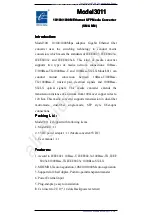
Installation and Operation Manual (Rev B)
PVI 10KW, 13KW, 15KW
3
DOCR-060011
2.0 Site Preparation and Inverter Placement
The inverter is comprised of a rainproof, industrial enclosure containing electrical and
electronic components and AC and DC integrated disconnects.
NOTE:
If the inverter is mounted outside, ensure that the enclosure doors remain
closed during the installation process in case of rain or snow. Leaving these doors
open during installation will void the warranty.
NOTE:
It is recommended to store the inverter indoors before installation.
If the
inverter is to be stored outdoors before being installed and commissioned, care must
be taken to avoid condensation inside the unit. Removing the protective shipping
wrap and placing a small space heater inside the unit can help minimize the amount
of condensation that can occur during onsite outdoor storage.
2.1
Criteria for device mounting:
•
Because the power electronics are within the rainproof enclosure, the inverter can be
mounted outdoors.
•
The maximum life for the inverter can be achieved by mounting the unit in a clean, dry and
cool location.
•
For optimal electrical system efficiency, use the shortest possible AC and DC cables and use
the maximum allowable cable size.
•
Avoid installation in close proximity to people or animals, as there is an audible high-
frequency switching noise.
•
Install the inverter in an accessible location following local electric codes for enclosure and
disconnect switch door clearances and proximity to other equipment.
•
Although the inverter is designed to function at full power continuously in up to 50
o
C
ambient temperature, for optimal inverter life and performance, do not mount the inverter
in direct sunlight, especially in hot climates. If the unit must be mounted in direct sunlight a
metal sun-shield is recommended. It is recommended that the inverter is mounted on the
north side of buildings or on the north side of a ground mount PV array.









































